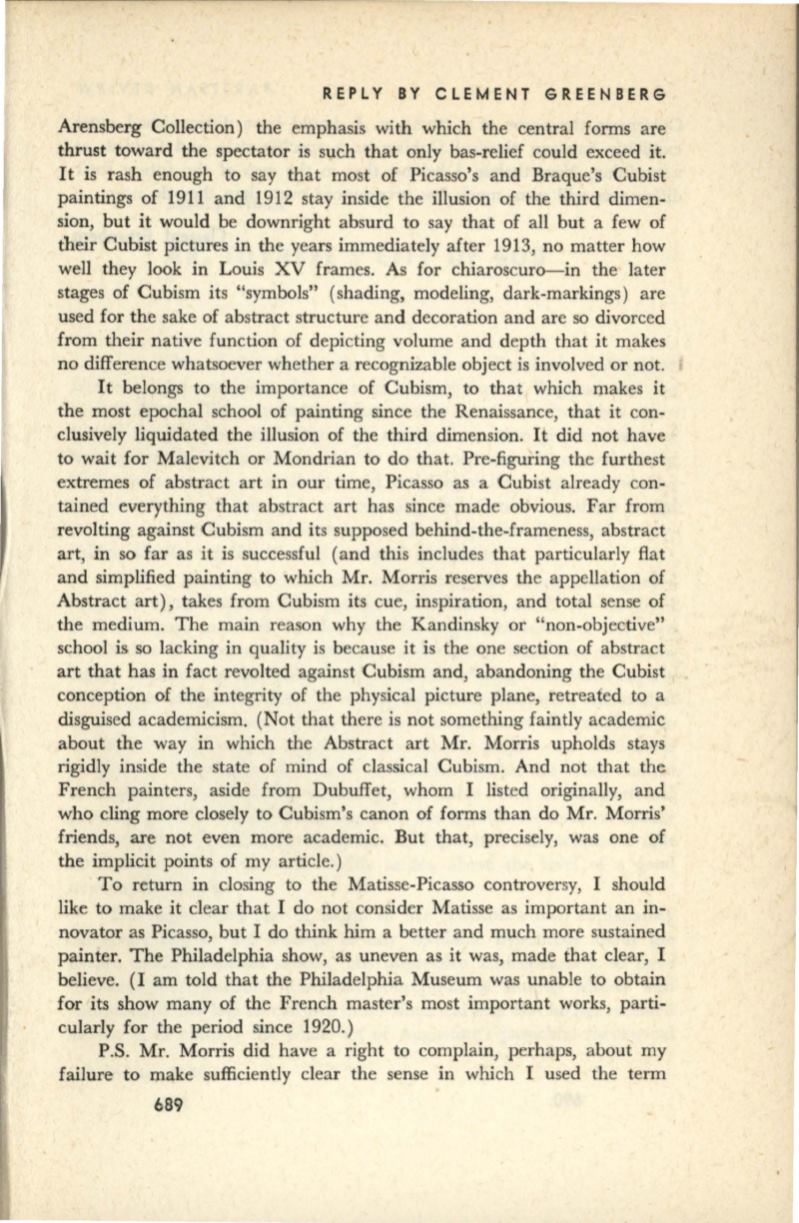
REPLY BY CLEMENT GREENBERG
Arensberg Collection) the emphasis with which the central forms are
thrust toward the spectator is such that only bas-relief could exceed it.
It
is rash enough to say that most of Picasso's and Braque's Cubist
paintings of 1911 and 1912 stay inside the illusion of the third dimen–
sion, but it would be downright absurd to say that of all but a few of
their Cubist pictures in the years immediately after 1913, no matter how
well they look in Louis XV frames. As for chiaroscuro-in the later
stages of Cubism its "symbols" (shading, modeling, dark-markings) are
used for the sake of abstract structure and decoration and are so divorced
from their native function of depicting volume and depth that it makes
no difference whatsoever whether a recognizable object is involved or not.
It belongs to the importance of Cubism, to that which makes it
the most epochal school of painting since the Renaissance, that it con–
clusively liquidated the illusion of the third dimension.
It
did not have
to wait for Malevitch or Mondrian to do that. Pre-figuring the furthest
extremes of abstract art in our time, Picasso as a Cubist already con–
tained everything that abstract art has since made obvious. Far from
revolting against Cubism and its supposed behind-the-frameness, abstract
art, in so far as it is successful (and this includes that particularly flat
and simplified painting to which Mr. Morris reserves the appellation of
Abstract art), takes from Cubism its cue, inspiration, and total sense of
the medium. The main reason why the Kandinsky or "non-objective"
school is so lacking in quality is because it is the one section of abstract
art that has in fact revolted against Cubism and, abandoning the Cubist
conception of the integrity of the physical picture plane, retreated to a
disguised academicism. (Not that there is not something faintly academic
about the way in which the Abstract art Mr. Morris upholds stays
rigidly inside the state of mind of classical Cubism. And not that the
French painters, aside from Dubuffet, whom I listed originally, and
who cling more closely to Cubism's canon of forms than do Mr. Morris'
friends, are not even more academic. But that, precisely, was one of
the implicit points of my article.)
To return in closing to the Matisse-Picasso controversy, I should
like to make it clear that I do not consider Matisse as important an in–
novator as Picasso, but I do think him a better and much more sustained
painter. The Philadelphia show, as uneven as it was, made that clear, I
believe. (I am told that the Philadelphia Museum was unable to obtain
for its show many of the French master's most important works, parti–
cularly for the period since 1920.)
P.S. Mr. Morris did have a right to complain, perhaps, about my
failure to make sufficiently clear the sense in which I used the term
689


